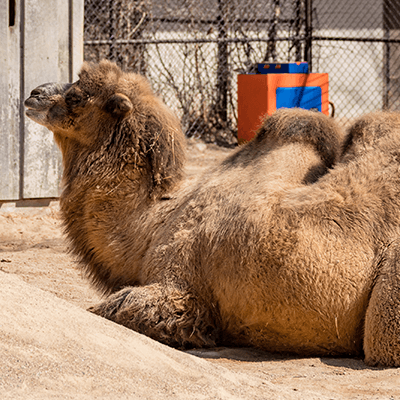
About Bactrian Camel
Did you know that camels have been domesticated for close to 3,500 years? They provide humans with transportation, materials to make leather and clothes, feces for heat, meat and fat for cooking, and milk. Sadly, wild camels are on the verge of extinction.
Habitat
Camels are a domestic species found throughout Asia (north of the Himalayan Mountains) and in dry habitats. They typically live in the desert in the spring/fall and grasslands (steppe) in the winter.
Diet
Camels eat plants (leaves, roots, bark, and stems) including dry, prickly desert plants.
Family Life
Camel’s calves are born at an average birth weight of 79 pounds – that’s a big baby! Calves are able to stand and run soon after birth and will nurse from their mother for a year and a half.
Conservation Status
The conservation status of the Bactrian Camel is classified as not evaluated.Threats
- Humans are the biggest threat to these animals. They harvest camels for meat, wool, bone, and other body parts. Due to hunting and other predators, the wild camels are a critically endangered species.
- Natural predators such as leopards and wolves are sometimes found roaming the camel’s habitat but tend to stay away from the camel seeing as they are harder to defeat due to their size.
Facts about Bactrian Camel
Class:
Mammalia (mammal)Order:
Artiodactyla (even-toed ungulates)Family:
Camelidae (camels)Genus:
Camelus (camels)Species:
Camelus bactrianus (bacterian camel)Life Span:
50 years (wild) / 20 – 40 years (zoo)Size:
7 – 11 feet (2 – 3 m)Weight:
661 – 1,521 poundsHeight (Shoulder):
6 – 8 feet (1.8 – 2.4 m)
Fun Facts
- There’s no water in the camel’s hump. It is actually around 80 pounds of fat which helps them survive when food is hard to find.
- They can go days without water. When it is available, they can drink up to 30 gallons of water in 10 minutes!